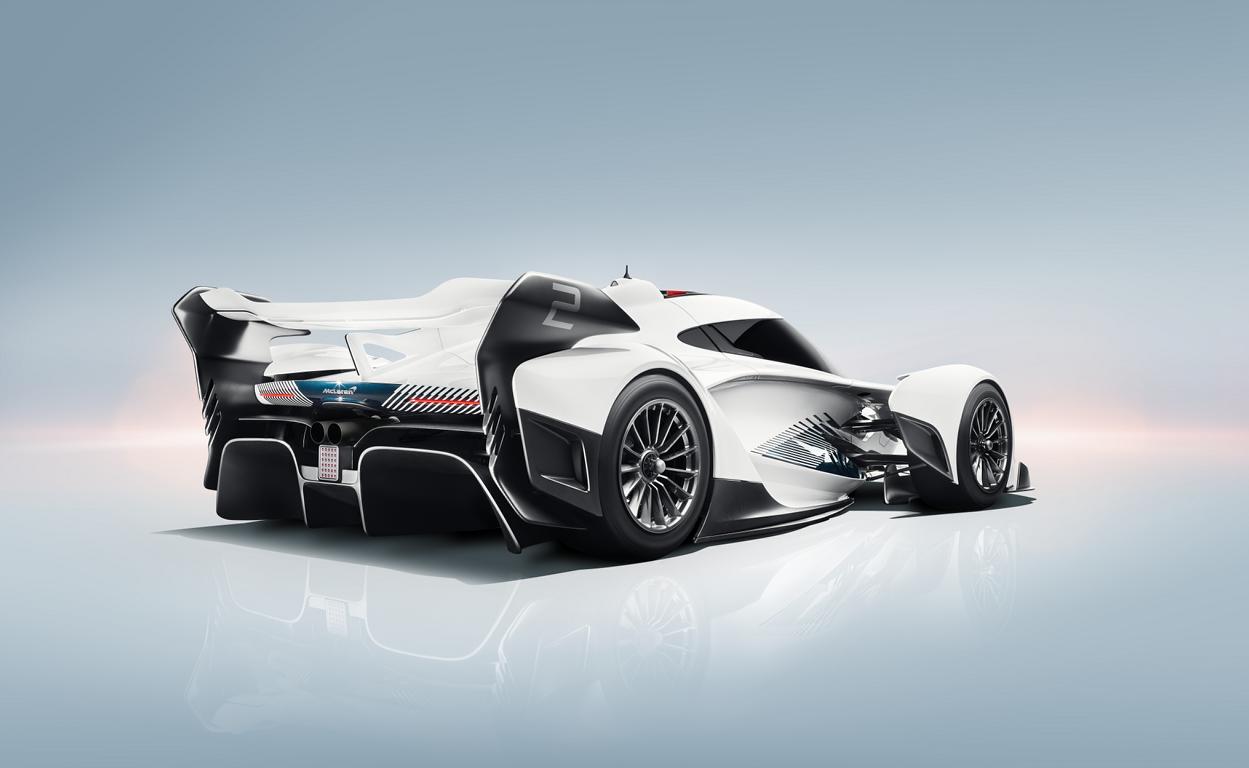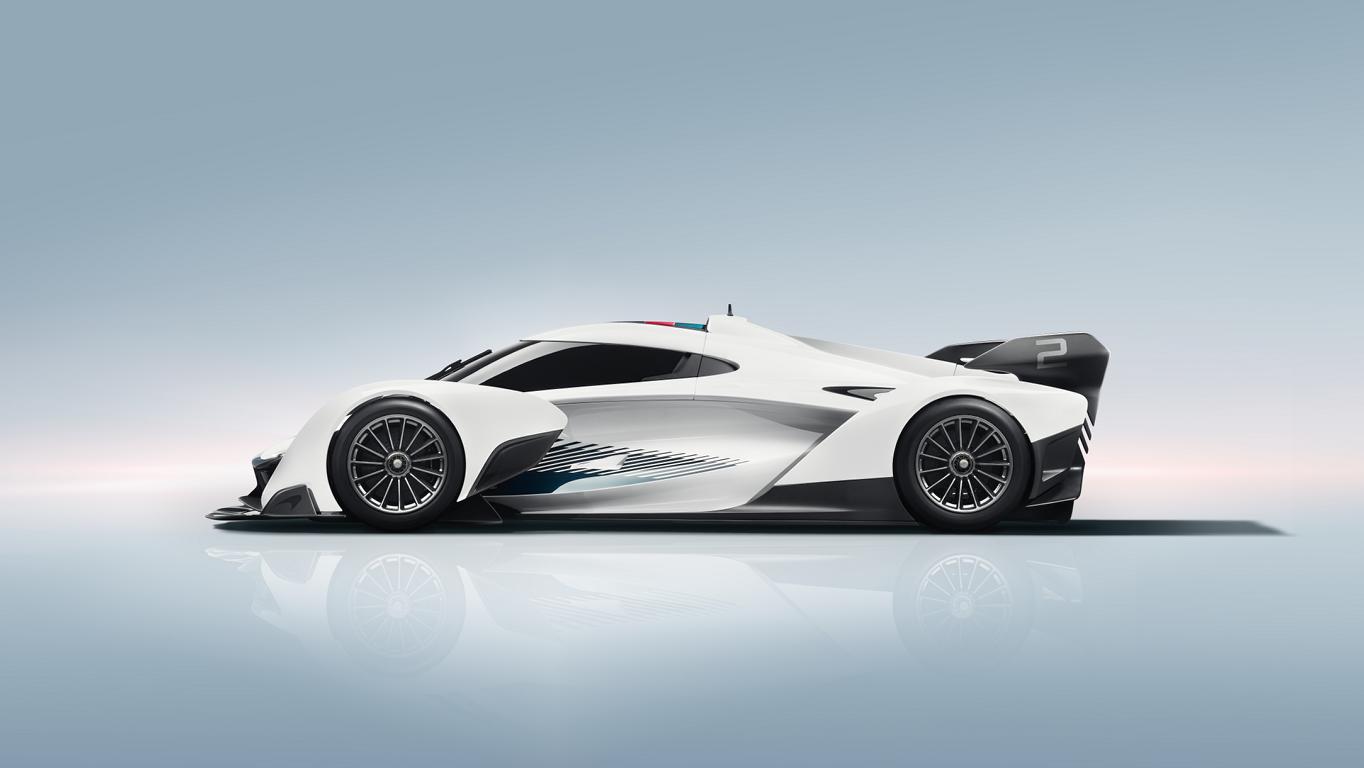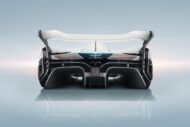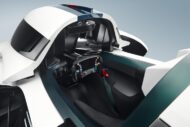Recently updated on August 25, 2022 at 09:52 am
McLaren Automotive today unveils the McLaren Solus GT, a stunning transformation of a concept vehicle from the virtual world of racing into an extreme racer that will also impress in the real world. The single-seat, closed-cockpit racer is custom-built for just 25 customers - all vehicles have already been sold - and was unveiled by Michael Leiters, Chief Executive Officer of McLaren Automotive, during Monterey Car Week in California. The Solus GT was developed using all of McLaren's experience and expertise at the highest levels of motorsport and supercar and hypercar development. It brings to life the futuristic McLaren concept from the video game Gran Turismo SPORT.
McLaren Solus GT
Weighing less than 1.000kg and aerodynamic performance with a powerplant in excess of 1.200kg, the Solus GT - which is powered by a naturally aspirated 5,2-litre V10 engine - is capable of the fastest lap times of any McLaren outside of single-seater racing and offers a driving experience close to that of a Formula 1 car.
“The McLaren Solus GT is the realization of a radical McLaren concept car originally developed for the world of virtual racing. Developed free of any restrictions imposed by road or racing regulations, but with the full spectrum of McLaren know-how to translate it into reality, it embodies our pioneering spirit.” Michael Leiters, Chairman of the Board, McLaren Automotive. Remarkably faithful to its virtual counterpart, the striking exterior design is based on proven aerodynamic principles and McLaren's "everything has a reason" design ethos, refined through additional CFD (Computational Fluid Dynamics) and wind tunnel aerodynamics research.
The list of distinctive exterior features is long, with the sliding hood over the single, central seat being one of the most notable. The wheels are encased in aerodynamic nacelles and are supported by wishbones. A large front splitter directs the air into ground effect tunnels before exiting the car through a full diffuser. A motorsport-inspired air intake above the cockpit, integrated into the roll bar cover design, delivers cool air to the engine while maintaining an appealing intake sound. The racing car design also inspired the sidepods that house the Solus GT's radiators.
A fixed two-piece rear wing is the key to a downforce that exceeds the total weight of the vehicle. The downforce to drag ratio has also been optimized, improving both straight line performance and cornering. The Solus GT experience begins even before the engine is started, when the driver opens the distinctive cockpit canopy, which slides forward in a shallow arc to allow access. This is not like a traditional car door, or even the signature gullwing doors of other McLaren cars, but more like stepping into a jet fighter.
there will only be 25 Solus GT owners
The way you enter the car adds to the feel of the single seat, which dominates the interior and focuses solely on the driver and performance. The seating position is fixed - 25 Solus GT owners will experience their own motorsport-style 'seat customization' - with a pedal box adjustable like in a race car, but with the convenience of a remote control system operated from the seating position. The steering wheel - whose design is unique to McLaren production cars - is inspired by Formula 1, with the dashboard and key controls integrated to suit the tight spaces of a single-seater racing car.
Looking behind the wheel is a glass dome with integrated halo-style cockpit protection, to which is attached a rear-view display fed by a wide-angle camera in the roll bar. The perfectly symmetrical 180 degree line of sight provided by the central driver's station is further enhanced by the dramatically designed wheel arches to help the driver position the car on the track. To further increase the driving pleasure for Solus GT customers, McLaren offers a complete "racer experience". This includes a driver's seat adapted to the driver's individual body shape, an FIA-homologated racing suit, a helmet and HANS device tailored to the respective owner, as well as radio-enabled ear tips. A comprehensive driver development coaching program is also offered to enable customers to realize the full potential of their new race car.
The Solus GT is powered by a unique 5,2-litre V10 engine, which is manufactured in small batches from machined components. It reaches a speed of over 10.000 rpm and offers extreme performance and an exciting driving experience. Engine response is enhanced through the use of drum-controlled throttle bodies for each cylinder - a system only suited to the racetrack - and is fully gear-driven, with no chains or belts for camshaft or ancillaries. The engine not only has a power output and torque of over 840 hp and 650 Nm respectively, but was also chosen for its structural qualities; for the first time in a production McLaren car, the engine is an integral part of the chassis. As is usual in racing car construction, this design approach optimizes weight reduction, since no additional chassis structures or subframes are required behind the carbon fiber monocoque.
The racing-derived seven-speed sequential gearbox, cased from aluminum with magnesium plates, is mounted to the rear of the engine, with the rear suspension attached to the gearbox. Inside the transmission are straight-cut gears that are shifted via a carbon fiber multi-disc clutch. The system is fully automatic and software-controlled, so the driver does not have to operate the clutch, which makes starting in the pit lane easier. Like every McLaren since 1981, the Solus GT is based on a carbon fiber monocoque, which in this case is manufactured using special low-volume production methods, including a carbon preg process for increased structural strength and high surface uniformity. The front and rear chassis structures are also made of carbon fiber, while the engine and transmission make up the rest of the chassis.
3D printed titanium components
Carbon fiber isn't the only premium material in the Solus GT. Borrowing technologies used in motorsport at the highest level, 3D printed titanium components were used for the Halo Cockpit protective structure and roll bar. This is the first time this process has been used for structural elements on a McLaren production car and allows for bespoke design and weight reduction. The suspension consists of double wishbones with internal torsion bar damping, which are actuated by push rods on the front axle and tie rods on the rear axle. Both axles are connected by anti-roll bars, with the driver having the option to adjust the suspension. The front suspensions are made of steel for durability and are encased by aerodynamic carbon fiber fairings, similar to those used in Formula 1.
The distinctive wheel arches house 18-inch forged-aluminum wheels with center-lock nuts, shod with Le Mans Prototype tires available in both slick and wet conditions. The brakes are served by 6-piston monobloc aluminum calipers, carbon discs and pads. The ratio between the front and rear brakes can be adjusted by the driver in the cockpit. Traditional performance figures are not as relevant for a race car, but with a target time of 2,5 seconds for acceleration from 0 to 100 km/h and a top speed of more than 200 mph - in combination with the low weight and strong aerodynamic capabilities of the vehicle - the McLaren Solus GT has the necessary performance data for an extreme racing machine.
The Solus GT brings together all the elements that have made McLaren a world-leading car manufacturer, while also being a showcase for the craftsmanship that McLaren Special Operations (MSO) offers to its customers. On a project like this, MSO's service goes beyond the car itself, reaching a level of luxurious customer engagement and accessibility only found at McLaren. A bespoken process ensures that every Solus GT is unique and regular updates on the development program will be offered, including access to prototype drives which may affect the car's handling characteristics even before production. Racetrack events are planned for the Solus GT and all vehicles will be delivered with a flight case. Included is an extensive tool kit, jack, stand, radio equipment and a coolant heater. The McLaren Solus GT is currently in the track testing phase of its development process. The first of 25 customer vehicles - all of which will be sold - will be delivered in 2023.
The McLaren Solus GT in detail - a concept for the virtual world becomes reality!
- Originally a virtual concept driven by millions of people in the video game Gran Turismo SPORT; now a reality as the amazing McLaren Solus GT
- Eye-catching cockpit with a single center seat and strong focus on aerodynamic principles throughout the vehicle
- Showcasing signature McLaren design cues, including the "hammerhead" front end, teardrop-shaped cabin and shrunken body
The roots of the McLaren Solus GT lie in a stunning concept presented in the video game Gran Turismo SPORT. From the original design sketches, to the virtual gaming triumph, to the amazing machine that few customers will enjoy on the race track, this is a car that embodies the design philosophy of "everything has a reason" and the relentless pursuit of technical excellence in each McLaren embodied. From the outset, the concept was based on proven aerodynamic principles, using a sports prototype race car package as the basis.
The body is a technical sculpture, welded in over the high-performance package and the two full-length ground effect tunnels. These include prominent air intakes at the front and a NACA duct - a low-drag air intake - which also acts as a step, accelerating airflow into the radiators. Viewed from the front, the distinctive McLaren hammerhead nose helps separate airflow from the underbody ground effects and full-length diffuser. Visibility from the wraparound canopy of the teardrop shaped cockpit is superb, offering an unobstructed 180 degree view of the track. The wheel arches at each corner are not only a dominant design feature, they also allow for weight reduction and individually "work" the airflow with a distinctive teardrop shape, culminating in a dramatic scoop-like trailing edge to calm the turbulent air in each tire's wake and reduce pressure build-up in the wheel housing to reduce.
The rear of the vehicle features full fairing allowing easy access to the engine compartment, with super flat rear body edges employing the same principles as the Speedtail to minimize ground pressure in the rear of the vehicle and reduce drag.
A virtual design in extreme reality
- Naturally aspirated V10 engine to optimize performance, rider engagement and packaging
- Aerodynamic performance has been integrated into the body surfaces using CFD (Computational Fluid Dynamics) and wind tunnel research to preserve the overall shape.
- Highly optimized structural work including monocoque geometry
The original technical brief for the McLaren Solus GT was to transform a prestigious virtual gaming concept into an extremely powerful and extremely exclusive McLaren hypercar. The Solus GT was intended to be a pure race car, bringing together motorsport engineering know-how and a V10 powertrain to offer the driver an uncompromising experience. The racing-derived engine was chosen for both packaging and performance reasons; a stripped-down race car with minimal weight and welded-in bodywork meant the engine as part of the chassis was a natural choice. This design technique is rarely found on production vehicles for NVH (noise, vibration, harshness) reasons, but on a purposeful race car it brings many benefits, not the least of which is additional feedback and exciting engagement for the driver. Once the program parameters were established, the engineering team faced the challenge of integrating real-world aerodynamic performance into the original design surfaces. This was solved with extensive CFD and wind tunnel work to prove the aerodynamic, cooling and efficient properties of the concept.
Racing inspired chassis design and construction
- The bespoke monocoque structure utilizes Formula 1 chassis technologies, with front and rear carbon structures
- Low bulk pre-impregnated carbon provides strength, stiffness and surface quality
- Engine and transmission are stressed chassis elements; the carbon crash structure is integrated into the transmission
- 3D printing process for structural components - titanium halogen protection and roll bar
Like every McLaren built in the last 40 years, the core of the Solus GT is a carbon fiber monocoque. However, the single-seat cockpit and production-based design processes required a tailored approach that takes into account the different disciplines of competition and road vehicle construction. The resulting design is more motorsport-inspired than other McLaren Automotive products, with the monocoque utilizing chassis technologies borrowed from Formula 1 and sports car construction. The front and rear impact structures are carbon fiber – traditionally McLaren Automotive have used aluminum chassis structures attached to the passenger compartment – and with both the engine and transmission being stressed chassis members, no rear subframe is required.
Special low-volume manufacturing methods are used in the construction of the chassis, including a “pre-preg” process in which the carbon fiber is pre-impregnated with a resin system that simplifies the curing process. The material can be placed in the mold prior to heat and pressure treatment, allowing for the higher structural strength required for a pure race car. The process also enables the material to have a very even surface, which increases its visual attractiveness. The chassis of the Solus GT also consists of 3D printed titanium components, including the protective structure of the halo cockpit and the roll bar. Although McLaren Automotive has used this technology before - notably for the Elva's exhaust system - this is the first use of this technology for structural components in a production McLaren car and shows that the best solutions have been found for the Solus GT.
Refined and optimized body and aerodynamics
- Carbon fiber body with aerodynamic surfaces such as front splitter, single wheel arches, structured floor with ground effect tunnels and fixed, two-piece rear wing
- With enormous drive - with 1.200 kg more than the weight of the vehicle - and minimizes the air resistance
- Formula 1 inspired carbon fiber suspension covers, air intakes and sidepod mounted radiators
Despite the freedom the development team enjoyed in exploring the possibilities of the Solus GT as a race car, the exterior design of the virtual reality concept limited the possibilities if the real car were to retain the "wow factor" of the Gran Turismo SPORT car . As befits an ultra-light racing car, the body of the Solus GT is made of carbon fibre. The complex shapes and curved lines were achieved without the weight penalty that would result from using traditional metal parts. The shape of the body has been fine-tuned – ironically in virtual reality – to ensure stability and maximize aerodynamic efficiency, both in terms of straight-line speed and downforce.
A large front splitter directs air into ground effect tunnels throughout the structural floor designed to withstand high aerodynamic loads. The air leaves the car via a full diffuser. The front wheels are external to the main body, with the suspension wishbones exposed to the airflow and encased in aerodynamically shaped carbon fibers that direct air to the sidepod-mounted radiators. Directly inspired by motorsport, the arrangement of the high-temperature coolers in the sidepods offers direct cooling of the engine fluids and reduces the frontal area.
A motorsport-inspired air intake above the cockpit, integrated into the design of the roll bar cover, draws in cold and calmed air above the vehicle while creating a pleasant, engaging engine intake sound. Consisting of two elements, the fixed rear wing is one of the most striking visual features of the Solus GT. Designed to maximize downforce at the rear of the vehicle, it works with the combination of high drive effect and low roll sensitivity of the motorsport-derived suspension system to negate the need for active front or rear wings, thereby reducing weight. Overall, the downforce of the aero package exceeds the overall weight of the car, but the downforce-to-drag ratio is also optimized, aiding straight-line performance and increasing cornering speed.
Unique, central individual seat in the interior
- The driver enters the vehicle through a sunroof with a Formula 1 style cockpit guard
- Single seat cockpit with fixed seat and adjustable pedals
- The most important controls and the TFT instrument display are mounted on the steering wheel with a carbon fiber structure
- Wide-angle rear view camera above the roll bar, linked to the driver's screen
The driving experience in the Solus GT McLaren begins even before the V10 engine is started - even entering the cockpit is an event in itself. Instead of the typical McLaren gullwing doors, a sliding hood, which is more like that of a fighter jet, is opened with a mechanical lever. The spring-loaded hood moves in a flat arc, lifting off the cockpit and sliding forward for easier access to the driver's seat. The latest technological safety innovations derived from motorsport are integrated into the design, with the canopy being reinforced with a halo-like structure to protect the driver. In addition, an emergency hatch is integrated into the canopy, which allows safe exit from the cockpit should the sliding mechanism become blocked.
The interior has been specifically designed for extreme performance on the racetrack. The owner can customize their car with a completely customized environment, but focused on the driving experience. The sculpted seat is fitted with a 6-point harness and fixed in position; instead, the pedal box is adjustable like in a race car, but can be conveniently operated from a seated position. To ensure the individual seat is perfectly tailored to the customer, MSO adopted a motorsport process, which is another example of all McLaren know-how being applied to the Solus GT. A phenolic resin based system with advanced microbead technology is used to create a mold from which the seat is made, which in turn ensures that the driver remains comfortably seated in the car even during the most intense journeys around the track.
Almost all controls are located on the steering wheel, which is made of carbon fiber. Directly inspired by motorsport, all key functions are within easy reach with both hands on the steering wheel. A full HVAC air system keeps the driver alert throughout the ride. Above the driver's head are the switches for the vehicle's ignition and the fully integrated emergency fire extinguisher. This area also houses the reversing display, which is streamed in real time from a camera mounted on the roll bar behind the driver's head. The wide-angle camera offers a comprehensive view of the track for overtaking traffic on a slow lap or for easier maneuvering in the pit lane.
Powertrain with a proven motorsport pedigree
- 5,2-litre naturally aspirated V10 engine derived from motorsport with a speed of over 10.000 rpm
- McLaren specific engine with crankshaft, displacement, air intake and exhaust system all specifically designed for the Solus GT
- Gear driven camshaft and auxiliaries, no chains or belts in the engine
- Throttle valves for the individual cylinders sharpen the throttle response
The 5,2-litre V10 engine that powers the McLaren Solus GT is integrated into the car's chassis structure. The displacement is unique to the Solus GT, as is the air intake and exhaust system. The intake system directs air to the cylinder throttles dedicated to each individual cylinder – a technology that is not roadworthy but offers distinct engine performance benefits, including improved throttle response.
The engine consists of low-volume machined components optimized for performance and is fully gear-driven; there are no chains or belts for ancillaries. The power is more than 840 hp, with the ram effect of the high air intake taking full effect and the engine revving over 10.000 rpm. The maximum torque is over 650 Nm. The result is an acceleration time of 2,5 seconds from standstill to 100 km/h and a top speed of over 200 mph, despite the Solus GT generating downforce in excess of its weight.
competition gearbox
- Seven-speed sequential gearbox
- Custom cast and aluminum body with magnesium panels; the rear suspension is attached to the gearbox
- Uses straight-cut gears derived from motorsport
- Carbon fiber clutch with automated software control for a combination of aggressive shifting strategy and user-friendly operation
The Solus GT features a seven-speed sequential transmission with race-bred internals housed in a purpose-built casting and housing that serves as the mounting point for the rear suspension. The case is made of aluminum, with magnesium panels for weight optimization. Originally developed for LMP sportscars, the transmission features straight-cut gears, a technology not typically used in production cars for NVH sophistication, but said to be more efficient than helical gears in a high-performance race car. The transmission is shifted by a carbon fiber clutch designed for an aggressive shifting strategy, as required in a race car. However, it is also fully automated and controlled by software, so there is no need for a pedal or clutch lever to assist the driver when exiting the pit lane.
Suspension with a track focus
- Formula 1 inspired suspension design with double wishbones and front pushrod and rear pullrod activated torsion bars
- Manually adjustable four-way dampers
- Includes anti-roll bars, vehicle-height springs and a spring and damper system with lift function
The McLaren Solus GT was designed from the outset as a pure race car and its suspension follows the principles of motorsport engineering, starting with the double wishbone suspension. The front wheels are mounted externally to the body, front damping is inboard with pushrods operating torsion bars and corner dampers. At the rear, the rods are connected to tie rods, and the rear suspension is attached to the gearbox housing.
The control arms and rods are machined from steel for durability, while the front suspension arms are encased in carbon fiber fairings for aerodynamics. The system also includes leveling springs and a spring and damper system. This creates a more aerodynamically stable profile that makes the car's dynamic behavior at high speeds more predictable, thus increasing driver confidence on high-speed circuits.
The distinctive wheel arches house 18-inch center-lock forged aluminum wheels shod with Le Mans Prototype tires available in both slick and rain tires. Brakes are actuated by 6-piston aluminum monobloc calipers with carbon discs and pads. The ratio between the front and rear brakes can be adjusted by the driver in the cockpit. Each axle is connected by anti-roll bars, which are connected to each other via wishbones. Both bars are adjustable.
The complete - and bespoke - MSO customer journey
- Complete customer journey with participation in product development
- Totally tailor-made product - every car is unique
- Full racer experience available including bespoke driver clothing and seat
The Solus GT showcases the level of craftsmanship available to McLaren customers through McLaren Special Operations. From the beginning of the development process, individual presentations were offered to customers who wanted to secure one of the 25 available cars. This was previously reserved for buyers of the McLaren Sabre, which is only homologated for the US market, while the Solus GT is a pure race car product and thus has a worldwide customer base. The 25 customers who purchased the Solus GT were also involved in the intricacies of evolving the car from the virtual to the real world, with new software developed by MSO at the heart of realizing each customer's vision. This bespoke, individual approach reflects an intimate approach to McLaren that goes beyond even the usual level of luxury experience and involvement.
Don't worry, of course that was far from being the case when it came to auto / auto tuning. Our magazine still has tens of thousands other tuning reports in stock. Do you want to see them all? Then just click HERE and look around. Or are you particularly interested in everything to do with vehicles of the McLaren brand? Then click on one of the following posts!
 tuningblog.eu Your magazine about tuning the car
tuningblog.eu Your magazine about tuning the car





























